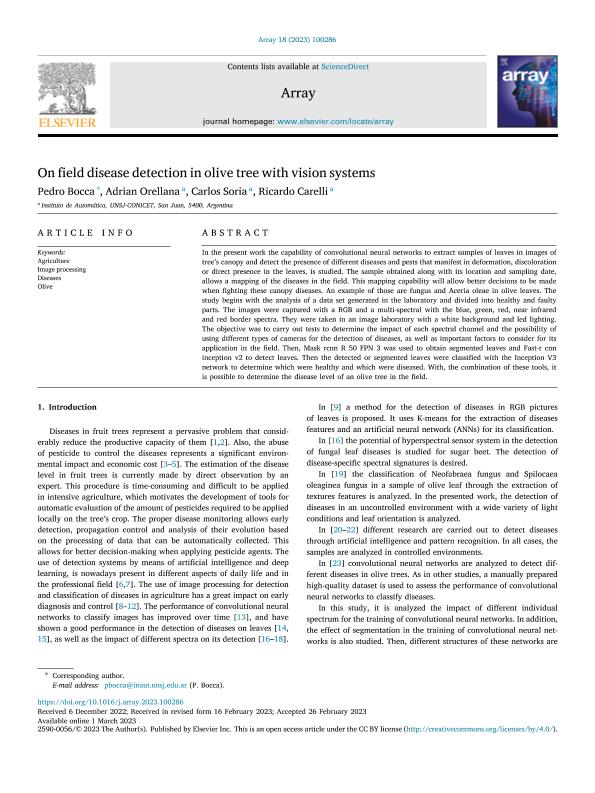Mostrar el registro sencillo del ítem
dc.contributor.author
Bocca Rodriguez, Pedro Daniel

dc.contributor.author
Orellana, Adrian Oscar

dc.contributor.author
Soria, Carlos Miguel

dc.contributor.author
Carelli Albarracin, Ricardo Oscar

dc.date.available
2024-02-19T15:46:09Z
dc.date.issued
2023-07
dc.identifier.citation
Bocca Rodriguez, Pedro Daniel; Orellana, Adrian Oscar; Soria, Carlos Miguel; Carelli Albarracin, Ricardo Oscar; On field disease detection in olive tree with vision systems; Elsevier; Array; 18; 1; 7-2023; 1-11
dc.identifier.issn
2590-0056
dc.identifier.uri
http://hdl.handle.net/11336/227510
dc.description.abstract
In the present work the capability of convolutional neural networks to extract samples of leaves in images of tree's canopy and detect the presence of different diseases and pests that manifest in deformation, discoloration or direct presence in the leaves, is studied. The sample obtained along with its location and sampling date, allows a mapping of the diseases in the field. This mapping capability will allow better decisions to be made when fighting these canopy diseases. An example of those are fungus and Aceria oleae in olive leaves. The study begins with the analysis of a data set generated in the laboratory and divided into healthy and faulty parts. The images were captured with a RGB and a multi-spectral with the blue, green, red, near infrared and red border spectra. They were taken in an image laboratory with a white background and led lighting. The objective was to carry out tests to determine the impact of each spectral channel and the possibility of using different types of cameras for the detection of diseases, as well as important factors to consider for its application in the field. Then, Mask rcnn R 50 FPN 3 was used to obtain segmented leaves and Fast-r cnn inception v2 to detect leaves. Then the detected or segmented leaves were classified with the Inception V3 network to determine which were healthy and which were diseased. With, the combination of these tools, it is possible to determine the disease level of an olive tree in the field.
dc.format
application/pdf
dc.language.iso
eng
dc.publisher
Elsevier

dc.rights
info:eu-repo/semantics/openAccess
dc.rights.uri
https://creativecommons.org/licenses/by/2.5/ar/
dc.subject
Agriculture
dc.subject
Image processing
dc.subject
Diseases
dc.subject
Olive
dc.subject.classification
Control Automático y Robótica

dc.subject.classification
Ingeniería Eléctrica, Ingeniería Electrónica e Ingeniería de la Información

dc.subject.classification
INGENIERÍAS Y TECNOLOGÍAS

dc.title
On field disease detection in olive tree with vision systems
dc.type
info:eu-repo/semantics/article
dc.type
info:ar-repo/semantics/artículo
dc.type
info:eu-repo/semantics/publishedVersion
dc.date.updated
2024-02-19T10:40:32Z
dc.journal.volume
18
dc.journal.number
1
dc.journal.pagination
1-11
dc.journal.pais
Países Bajos

dc.journal.ciudad
Amsterdam
dc.description.fil
Fil: Bocca Rodriguez, Pedro Daniel. Consejo Nacional de Investigaciones Científicas y Técnicas. Centro Científico Tecnológico Conicet - San Juan. Instituto de Automática. Universidad Nacional de San Juan. Facultad de Ingeniería. Instituto de Automática; Argentina
dc.description.fil
Fil: Orellana, Adrian Oscar. Consejo Nacional de Investigaciones Científicas y Técnicas. Centro Científico Tecnológico Conicet - San Juan. Instituto de Automática. Universidad Nacional de San Juan. Facultad de Ingeniería. Instituto de Automática; Argentina
dc.description.fil
Fil: Soria, Carlos Miguel. Consejo Nacional de Investigaciones Científicas y Técnicas. Centro Científico Tecnológico Conicet - San Juan. Instituto de Automática. Universidad Nacional de San Juan. Facultad de Ingeniería. Instituto de Automática; Argentina
dc.description.fil
Fil: Carelli Albarracin, Ricardo Oscar. Consejo Nacional de Investigaciones Científicas y Técnicas. Centro Científico Tecnológico Conicet - San Juan. Instituto de Automática. Universidad Nacional de San Juan. Facultad de Ingeniería. Instituto de Automática; Argentina
dc.journal.title
Array
dc.relation.alternativeid
info:eu-repo/semantics/altIdentifier/url/https://www.sciencedirect.com/science/article/pii/S2590005623000115
dc.relation.alternativeid
info:eu-repo/semantics/altIdentifier/doi/http://dx.doi.org/10.1016/j.array.2023.100286
Archivos asociados
